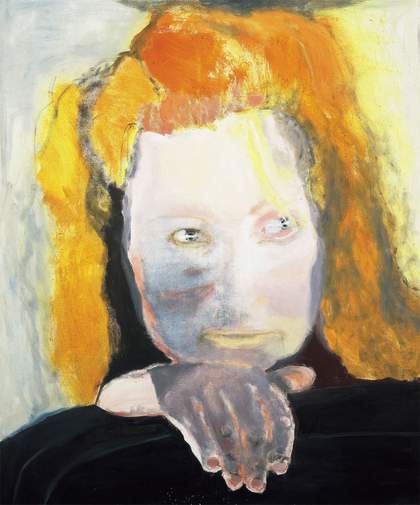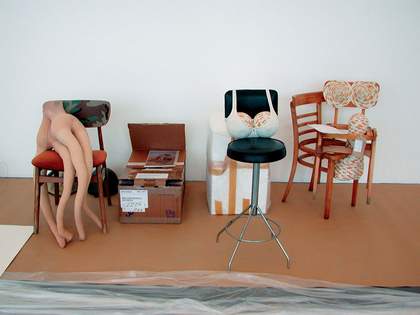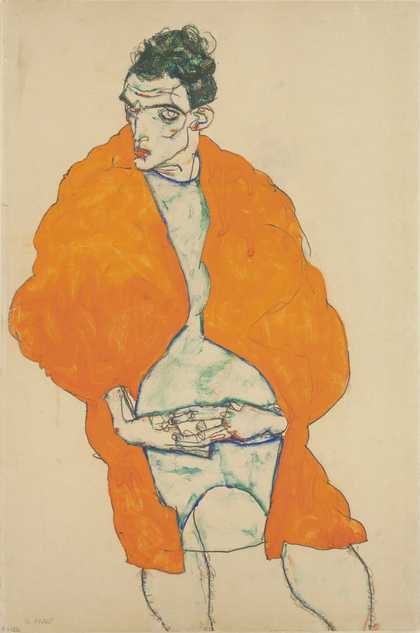
Allen Jones
[no title] (1976–7)
Tate
The distinction between erotic art and pornography is often debated, but rarely agreed upon. As western society becomes increasingly liberal, art becomes more experimental and the distribution of porn, commonplace. As a result art and pornography continue to merge.
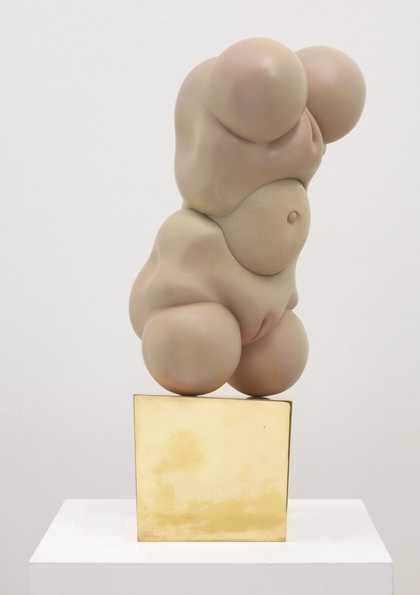
Hans Bellmer
The Doll (1936, reconstructed 1965)
Tate
For many, the porn industry represents an archaic and outmoded view of women. It continues to promote an ideology of objectification and submission which is considered anti-progressive. There is concern that by normalising sex and subjugating the actors, porn and pornographic art may go as far as to encourage sexual violence.
Helen Longino defines ‘Pornography’ as:
A verbal or pictorial material which represents sexual behaviour that is degrading or abusive to one or more of the participants ...
This criteria often extends into the realm of art. In reference to Rene Magritte’s The Rape 1935, Susan Gubar said:
Because such an image of mindless physicality justifies rape ... [it] can be understood as a clear and present danger to women.
This idea can be applied to a number of other artworks; the headless, limbless female form in Hans Bellmer’s The Doll c.1936, is another example.
Art acts as a mirror to the culture of its time. As our attitude towards sex becomes more inclusive, art continues to include sex in its canon with increasing, although tentative, acceptance. Where James Joyce saw his novel Ulysses 1922, banned for 10 years due to ‘explicit’ passages, and Egon Schiele served jail time for producing erotic drawings; we now see sex becoming a relevant and provocative conversation within contemporary art.
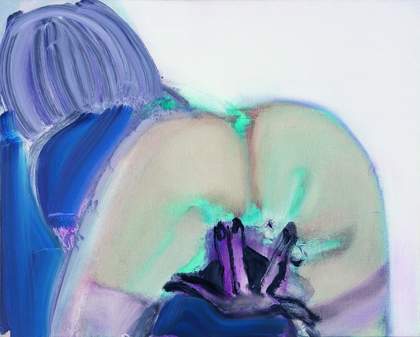
Marlene Dumas, Fingers 1999, 1999 © Marlene Dumas
Marlene Dumas has produced studies taken from mass produced pornographic images. This grants them, what Dumas calls, an ‘amoral touch’. It is interesting that she painted porn and not a life model in order to convey neutral morality. Just as ‘amoral’ stands directly between good and bad, and so, it seems, Dumas, refuses to pass judgement. Germain Greer develops this idea:
It seems to me that her frame of reference includes the rest of us in a ... culture that lives by prostituting everything, including art
- The Guardian, 22nd August 2010
In 1986 Dumas also drew an interesting distinction between the erotic and the pornographic:
At the moment my art is situated between the pornographic tendency to reveal everything and the erotic inclination to hide what it’s all about.
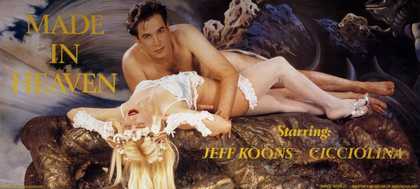
Jeff Koons
Made in Heaven (1989)
ARTIST ROOMS Tate and National Galleries of Scotland
On the basis of this point of view, it could certainly be argued that Jeff Koons’s series Made In Heaven 1989, is not art, but porn, since it leaves nothing to the imagination. Yet, as is the nature of the debate, Koons himself would not agree:
I’m not interested in pornography, I’m interested in the spiritual, to be able to show people that they can have impact, to achieve their desires.
-1990
This statement suggests Koon’s used pornographic images to transmute a concept beyond promoting sexual gratification. He wanted to elevate porn into art by giving it spiritual depth. Many critics believed Koon’s failed spectacularly in his intention but others responded more positively:
Opposing opinions and interpretations are a given within contemporary art, so some feel the only quality that can really be measured is the intention behind the work. Others argue that the artist’s intention holds less precedence than the experience of the model. Koons’s wife had starred in Porn films before, nevertheless even a practised performer can feel exploited:
I would like to be a wife who had been married to the same man for 30 years, with lots of children and grandchildren around. Instead, I am a woman alone… I did what I did, and I’m happy about it. But all the men around me exploited my sexy nature to take me to bed or to make money. As if sexual libertinism inevitably implied the absence of love and of sensitivity. I am a very romantic person, but nobody ever realised it….I repeat, I regret nothing – but I believe that I was never loved.
– The Independent/ Ilona Staller
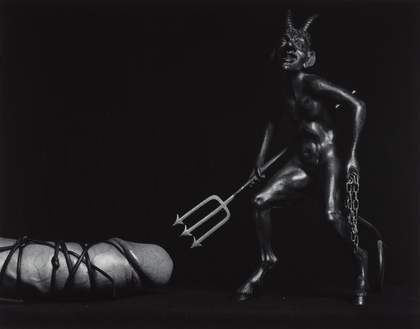
Robert Mapplethorpe, Cock and Devil 1982, printed 1990. Robert Mapplethorpe Foundation
Staller’s experience suggests that it was not the porn industry that caused her unhappiness, but the implication of porn in people’s minds. Pornography itself could have the potential to move beyond being symbolic of violence and female oppression, as we see in the relatively new genre of ‘female-friendly’ porn being produced today. Likewise if art is to reflect the experience of the artist, and also be, for many, an act of self-expression, then sex as subject matter for art should not be disregarded or censored. Hans Maes made this case in his essay Who Says Pornography Can’t Be Art? 2012:
Sexual experiences involve the deepest corners of ourselves and are among the most intense, powerful, emotional, and profound experiences we have. If pornography, which offers the most direct representation of, and access to, such experiences, can in principle be lifted into the realm of art…then I think we have every reason to encourage artists to attempt just that, to make intense, powerful, and profound works of pornographic art and rescue this much-maligned genre from the clutches of the seedy porn-barons.
If Maes is right, then it is not the distinction between Porn and Art which is the problem, but merely what Gubar calls the ‘ghettoizing’ of pornography. This encourages society to classify pornography as illicit and obscene, even when it is presented within an artistic context; as seen with the film series Destricted which was screened at Tate Modern in 2006. If the intention and direction behind pornographic films and images continues to change it may eventually reach acceptance within the art world, then perhaps we can move past what Dumas describes as the ‘porno blues’:
The muse is exhausted
too many bodies and not enough soul. She’s got the porno blues.
- The Muse Is Exhausted 1990

